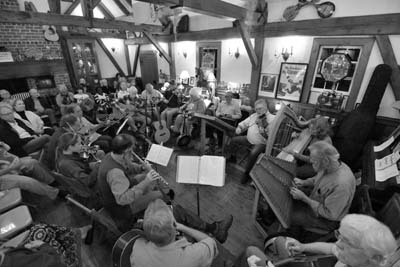Really Fine People
O'Hurley's Home to Sweet Music
Text and photographs by Carl E. Feather

Musicians perform in O'Hurley's Great Hall during the Thursday night jam session.
Photograph by Carl E. Feather.
On the day Jay Hurley held the grand reopening of his family’s Shepherdstown store, an “educated lady” peeked in the door, looked around, and delivered one of the nicest compliments O’Hurley’s General Store ever received.
“She stood in the middle of the doorway and said, ‘Attention to detail,’” Jay says. “It was a well-placed compliment. I will go the extra measure to get the detail I want.”
At times, going that extra measure involves driving across the countryside to track down a craftsman who builds a rocking horse or clothes drying rack to Jay’s standards. Because O’Hurley’s eschews goods and packaging made of plastic, Jay pays extra to have an item made from metal and the manufacturer to package it in a cardboard box rather than a blister pack. This obsession with detail means that O’Hurley’s deals with up to 150 different suppliers and craftsmen, many of them “grassroots operations,” like O’Hurley’s itself.
Jay imparts these values to employees Genevieve O’Loughlin, who manages the store, and Loretta Shorts. Jay pretty much gives these women carte blanche when it comes to buying and displaying merchandise but will chastise them for getting “carried away” with what he calls “foo-foo” items.
“If I was totally focused on the store, I’d be more into homesteading supplies. They are needed,” he says. Then again, Jay is not one to allow the market to drive his vision.
“Making money has never been my primary driving force,” he says.
Jay spent eight years tweaking his concept before moving back to West Virginia to take over the business from his father, Milburn Glenn “M. G.” Hurley.
“I could see in my mind the merchandise that I wanted in my store. It’s all merchandise that you would expect to see in a general-store atmosphere. I wanted useful, practical, functional, and nonplastic,” Jay tells me as we sit in The Great Hall of his East Washington Street store.
Our conversation is periodically interrupted by the horn and rumble of a Norfolk Southern Railway freight train passing so close you could almost shake hands with the engineer. Jay is unfazed by the racket; he grew up hearing the roar of steam locomotives on this line.
“I was born 150 feet from the tracks,” Jay says, referring to his home birth in 1941. This gave Jay a front seat to railroading as he watched the locomotives pass, their firemen feeding the voracious belly at the rear of the contraption, and smoke puffing out the top. Curious about the engineering of these beasts, Jay soon was asking questions like, “Why does the smoke come from the opposite end of the engine?” and “Why does it make a ‘poof, poof’ sound rather than a continuous roar?”
Jay says his family was poor, and there was rarely money for travel, but he recalls a glorious moment in his childhood when his mother, Ruth (Smith), (She wasn’t a Hurley?) took him and his brother to the railroad depot about two blocks from their home and purchased three tickets to the next stop: Sharpsburg, Maryland. He still recalls the thrill of crossing the Potomac River on the high-level bridge and seeing the legendary waterway from a new vantage.
“And then we got off the train and walked the four miles home,” he says.
Jay had no interest in taking over his father’s store or staying in Shepherdstown after high school. He worked on farms around the area then headed off to Chicago, where he earned a degree from DeVry and dabbled in radio for several years. His training helped him land a job with General Electric, which assigned him to a remote radar site in the Aleutian Islands. Next was an assignment in Turkey, where he was “adopted by a Moslem” family. From there, Jay worked in the automotive industry in Michigan.
By the mid-1970s, M. G. Hurley was terminally ill. Jay’s brother had no interest in the store, so Jay decided to carry on the family business and become his mother’s caregiver. He disposed of his investments in Michigan and returned to Shepherdstown with about $20,000 to his name—money he would invest to transform his store.
“Dad died one-and-a-half months after I got here,” Jay says. “I spent the first year collecting the materials I’d need to rebuild the store.”
Jay revamped the store’s interior to give it a more authentic late-1800s look. He spent half his life savings on the renovation, most of which he did himself with help from college kids he paid by the hour.
“But the most difficult part was spending $10,000 on merchandise,” he says. “I’d never run a store, but I knew the kind of store that I wanted. . . . It was two to three years of living on cheese and crackers. Any (cash) that came in went into more merchandise.”
You can read the rest of this article in this issue of Goldenseal, available in bookstores, libraries or direct from Goldenseal.